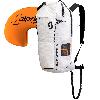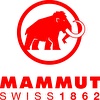Extreme skiing, when falling is simply not an option

 1 / 22
1 / 22 archivio Davide Capozzi
archivio Davide Capozzi
Davide, let's start from the most obvious beginning: what does extreme skiing mean?
I think that the term extreme skiing comes into play when you ski down slopes which are steeper than 40°. This isn't the main component though, as there are other factors which come into play, such as the orientation of the slope and the prevailing snow conditions. There's a big difference between skiing down a sheet of 40° ice and enjoying perfect 50° powder. There are different ways of grading descents, the most popular being the toponeige, but personally I don't really like giving a descent a grade, like a rock climb has. There are simply too many factors which come into play.
Would it be right to say that in extreme skiing the rule number one is to simply not fall?
At times it's best not to fall, other times it is absolutely forbidden to fall. This is because the exposure of a given slope is one of the main factors in extreme skiing. I vividly remember my first steep descents, I found it really tough to not think about the void beneath my snowboard, even on descents which weren't that extreme. Slowly but surely though you get used to it all and you begin to think about the next curves only, you no longer think about what lies beneath you. This is exactly what happened when I skied the Mont Rochefort last year.
Is there a substantial difference with freeriding?
Yes, in extreme skiing the main component is alpinism, seeing that you first ascend the slopes which you then ski down, and usually it's best not to fall, ever. Freeriding is all about fresh powder, great speed, jumps. The main risks are associated with the stability of the snow cover.
Who are those who have left their mark?
There are numerous alpinist skiers who have contributed to the history of extreme skiing. I usually ski in the Mont Blanc range and I have to therefore mention the Italian Stefano De Benedetti. He wrote important chapters in the history of extreme skiing, descended all the faces of Mont Blanc and culminated his career with the descent of the Via Innominata, but one mustn't forget his descents of the via Major or the Blanche de Peuteurey, down two different lines along the East and North Faces. In France the people who need mentioning are Anselme Baud, Patrick Vallençant, Jean-Marc Boivin and Pierre Tardivel, but there are many more of course. It's difficult to sum up the entire history of this sport in just a few lines and I'm sure there are many others who can do this far better than me.
What about snowboarders?
Dédé Rhem and Jerome Ruby certainly deserve a mention: apart from being extremely talented mountaineers, they left their mark with incredible descents, of which the North Face of the Triolet stands out as the jewel in the crown. At Marco Siffredi needs mentioning, too. He died while descending the Horbein Couloir on Everest, but before that he managed to descend the Norton Couloir on Everest. Of his numerous descents the Mont Blanc range, his first descent of Nant Blanc on Aiguille Verte after Jean-Marc Boivin stands as fine testament to his talent
Many of the names you've mentioned belong to a different generation.
Tardivel is active even today, he is one of the few who continue to carry out steep descents and search for new lines. It's obvious though that one remembers the names of the skiers of the previous generations, seeing that they were the ones who carried out incredible first descents, making the most of the golden age between the 1970's and '80's.
What are the classic descents which any budding extreme skier simply has to do?
I can only talk about the Mont Blanc as this is the area I know best, and even if I can't really recommend one descent in particular, it is certainly true that there are some lines which are important objectives for many, such as the Courtes NNE Face, the Whymper, the Couturier on Verte or the Gervasutti on Tacul. These descents have become a symbol for extreme skiing in the Mont Blanc.
How often are they skied in a good season?
In good conditions these descents can be skied by many people. It's hard to pinpoint exactly how many but I've often seen more than a dozen skiers ascent the NNE Face of the Courtes to then ski it.
What's the situation like here in Italy?
There are more extreme skiers in Italy than you might think, some of whom are very talented indeed and they often prefer to remain out of the limelight.
You recently carried out a series of descents above the remote Miage glacier, but your descents were done in a single day. What has changed?
The substantial change is that these descents used to be carried out in spring, nowadays we tend to ski these lines earlier on in the season and the conditions this January were such - read constant cold and stable – that we could reach the Miage in a single day thanks to the lifts which are closed in spring. And in recent years we've often encountered spring conditions in mid winter, so it was simply impossible not to make the best of it.
Tell us about the gear – how important is the “right” ski or snowboard?
These descents usually require a fairly rigid snowboard, not particularly long and not too narrow. But you don't really need any specific gear, what counts most is to always use the same gear so that you're familiar with how it handles.
Great classics or new descents? What motivates you most?
I began by skiing the classics because they were the most obvious lines and I wanted to test myself, and even today there are some classics I want to ski as I believe they are extremely beautiful. Having said that though, descending a new line is a natural step forward and I'm constantly on the lookout for a possible new line. Imagining a new descent and then actually skiing it for the first time makes you feel as if it's YOURS. Regardless of how difficult it is.
How much time do you spend searching for new lines and how do you choose the right moment?
Every day in the mountain is spent looking at lines, it's something completely natural, I don't need to make the effort. The mountains which surround me are so beautiful that looking at them is a delight. Once I've found a possible descent I talk to my friends, we try to understand if it's feasible or not. Then I wait for the right conditions which equate to safety. Or at least I try.
Are you often forced to turn back?
Yes, we often turn back, other times we simply don't even attempt the line. Sometimes though it's too late to turn back and you need to get yourself out of the mess, and the right solution is often the longest haul. Unfortunately this is an integral part of the game: regardless of how much you attempt to do things right, it's inevitable that every once in a while you can make a mistake.
Extreme skiing alone or as a group. What do you prefer and what changes?
I prefer being with just a few people, the right ones. If I have to choose, I prefer to be alone than with a large number of people, as my worst experiences in the mountains have always been when there were too many of us.
Last question: you often talk about Mont Blanc, your backyard. But there are obviously many other descents on even bigger mountains, up to the 8000m giants. Will we see you leave your tracks there one day?
It would be fantastic. I'd love to descend an 8000er or a 7000er down a slope which is as difficult and steep as those here in our Alps. Marco Siffredi had attempted this and the Hornbein Couloir on Everest is a perfect example, but for me I think it'll remain a dream. I'm more than happy to make do with the Alps. Which aren't too bad, really...
Davide Capozzi - his most important descents in the Mont Blanc range
Monte Bianco, 4810 mt Face West, Via De Benedetti, 45/55° TD+ (1st descent)
Monte Bianco, 4810mt Sperone della Brenva and Glacier Brenva, 45°/50° TD
Monte Bianco, Brèche N des Dames Anglaises, 3491 mt, couloir NE, 55° TD (1° discesa)
Mont Maudit, 3900 mt Voie Anderson, 50°55°TD (1st descent)
Grandes Jorasses, 4208 mt. Face Sud, 45°/50° D+
Mt Blanc du Tacul, 4248 mt Couloir du Diable, 45/55° TD+
Mt Blanc du Tacul, 4248 mt Couloir Gervasutti, 45/55° TD
Mt Blanc du Tacul, 4248 mt Couloir Jager, 50/55° TD+
Mt Blanc du Tacul, 4048 mt Col du Diable, Couloir Macho 45/50° TD
Les Droites, 4000 mt Sommet W, 45/50° TD
Les Courtes, 3856 mt Couloir Chenavier, 50°/55° TD+
Les Courtes, 3856 mt Voie Cordier-Gabarrou, 45°/50° TD+
Les Courtes, 3856 mt Face S, 45°/50° TD
Les Courtes, 3856 mt Eperon NE, 45°/55° TD
Les Courtes, 3856 mt Face NNE, 45°/50° D+
Les Courtes, 3856 mt. Couloir Direct S, 45°/50° TD
Col des Courtes, 3612 mt. Face NE, 50°/55° D
Col des Cristaux, 3601 mt Face NE, 45° D
Col de l’Amone, 3540 mt. Couloir SW, 45°/50° D
Col Armand Charlet, 3998 mt Couloir S, 50°/55° TD
Col du Tacul, 3337 mt Couloir N du Capucin, 45°/50° D+
Domes de Miage, 3670 mt. Arète Mettrier, 45°/50° D+
Aiguille Verte, 4122 mt. Couloir Whymper, 45°/55° TD+
Aiguille du Chardonnet, 3823 mt Face W, 45°/55° TD
Aiguille d'Argentière, Couloir Barbey, 45°/50° D+
Aiguille du Gouter, 3817 mt Couloir Pollux, 650 mt 45° D
Aiguille Eboulement, 3599 mt Couloir S, 45° D
Aiguille du Toula, 3534 mt Face N, 45°/55° D+
Aiguille du Tacul, 3444 mt Face N, 45° D
Aiguillettes du Tacul, 3913 mt Couloir E, 50° TD
Aiguillettes du Tacul,3919 mt Couloir SW,45° D+
Aiguille Rochefort,4001 mt Couloir S, 45,55° TD (1° discesa)
Mont Rochefort, 3456 mt Face SW,45°50° TD (1° discesa)
Aiguille Berangere, 3425 mt Couloir W,45° D+
Tricot P.te Inf., 2830 mt Face N,45° D+ (1° discesa)
Tour Ronde, 3792 mt Face N, 50/55° TD
Tour Ronde, 3792 mt Couloir Gervasutti, 45/50° D+
Tour Ronde, 3792 mt Couloir S Glacier Brenva, 45° D+
Tour Ronde, 3627 mt. Col Est, 50° D
Tour Ronde, 3661 mt. Col Ovest, 50°/55° D (1st descent)
Triangle du Tacul, 3970 mt Voie Contamine Negri, 50/55° TD
Calotte de la Brenva, 3703 mt Couloir NE,45°/50° AD (1° discesa)
Noire, 3402 mt Face Nord, 40/50° TD
Mont Mallet , 3800 mt Face W, 50°/45° D+
Petit Mont Blanc, 3424 mt Couloir NE, 40/50° TD
Tète Carré, 3726 mt Couloir E, 40/50° D+
Breche Puiseux, 3432 mt. Couloir SW, 45°/50° D+
Dent de Geant, 3970 mt Face SE, 45°/50° D+
| Links Planetmountain | |
| News Davide Capozzi | |
| News Mont Blanc | |
| Rock climbing on Mont Blanc | |
| Links Expo.Planetmountain | |
| Expo The North Face | |
| Links www | |
| www.snowhow.it | |



 Copia link
Copia link


















 See all photos
See all photos






















